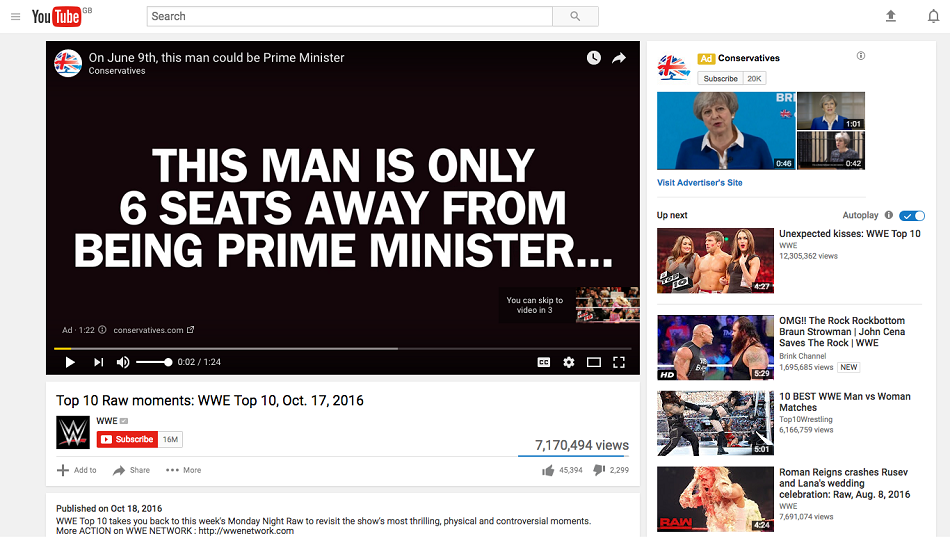Who's aiming for the Snapchat vote?
- Published

A Conservative ad on Snapchat, thought to be the first UK political ad on the platform
BBC Trending has discovered a trend towards paid-for UK election advertising in entirely new places, including Snapchat, mobile phone games, and YouTube wrestling videos.
Rosanna Lowe was listening to soothing Georgian and Gregorian music on YouTube when political advertising broke her reverie. Lowe says that, on one recent day, she clicked on 15 different songs - and each was preceded by a Conservative advert.
"It was like I was going mad," Lowe told BBC Trending. "It was like I was trapped in some kind of Tory Groundhog Day."
YouTube adverts appear to be a one big component of the Conservatives' digital campaign. But there is evidence to suggest that the political parties are not able to target YouTube users with much precision.
Along with BBC Newsnight and local radio, Trending has crowdsourced more than 500 political adverts across social media platforms. On Facebook, we've reported on the big money campaigns of the major political parties, and the self-funded efforts of grassroots groups. But a lot of ads are served up on other platforms too - with YouTube being the biggest - and in recent days we've noticed curious things about how broadly these are being 'served' to audiences.
James McAteer was watching WWE (World Wrestling Entertainment) videos on his laptop when he saw a Conservative advert criticising Labour leader Jeremy Corbyn. This advert has gone viral online - perhaps boosted by paid-for advertising - but McAteer was taken aback when he was shown it on YouTube.

This Conservative attack ad has been viewed 6 million times online.
"I knew that the political parties were advertising on social media, but it didn't seem appropriate for me to see this advert," he says. "When political ads are shown in a party political broadcast on TV we are told what it is and I can choose to watch or not. With this type of ad I have little or no choice to listen or watch."
This type of apparently general advertising differs from the highly targeted Facebook campaigns coming from the major parties, who have made use of data collected by the social network, including age, location and political views - which can be either provided by Facebook users, or deciphered from their "likes". For instance, the Conservative Party has targeted voters in key constituencies with anti-Jeremy Corbyn ads.
On YouTube, things are different. Viewers, listeners and readers have reported that they've seen Conservative YouTube ads in some of the safest Labour seats in the country, and many people unlikely to vote Tory have also been served the ads.
Chris Evans was chatting to his 10-year-old son about the upcoming general election, when his son firmly responded that he did not support Corbyn because of the Labour leader's stance on NATO.
Evans, a member of the public who sent us the advert, was surprised by this mature contribution. However, when he pressed his son on the source of this information - presuming he'd overheard a teacher or a school friend - he found that his son's anti-Corbyn attitude had in fact been shaped by Conservative adverts on YouTube.
"Frankly, I was shocked - as perhaps I was naively unaware of political advertising on YouTube," he told Trending. "As he rarely watches TV, the internet is now a primary source of information. The problem is, these ads are not the subject of balanced debate and argument."
But not all voters share such concerns. Another person who sent us an ad, Mike Quinn, saw a Conservative advert on YouTube while he was watching guitar pedal demonstration videos. He doesn't see much difference between traditional ads and social media campaigning. "In principle, YouTube advertising is no different to the old-school loudspeaker vans that used to go around the streets urging us to 'Vote for the Labour Party' or party political broadcasts," he told Trending.
Paid-for political advertising on TV is banned in the UK, but the Electoral Commission told Trending that there are no specific laws regulating the output of political advertising on YouTube or any other social network. "The political parties just have to report their total YouTube and social media spending to the Electoral Commission after the election," a spokesperson said.
Political adverts on social media are also less visible than traditional forms of advertising, such as billboards, because social media ads generally can only be seen by those individuals who receive them.
More on political advertising from BBC Trending

Filter Bubble Britain: General Election coverage from BBC Trending


In addition to YouTube, the Conservatives seem to be expanding their advertising footprint to Snapchat. Several individuals reported seeing Tory adverts on the youth-oriented network - including one who saw a Conservative advert just after he had finished watching a Snapchat story from Jeremy Corbyn. It is not clear how that ad reached the user; whether the Conservative Party paid for it to be delivered to Corbyn's Snapchat followers. However, it's clear that the Conservative Party is trying to spread its reach across a wide range of social networks.
The majority of adverts seen by our readers have been paid for by the Conservatives. This might be explained by our unscientific methodology - Labour supporters might have been more motivated to send us examples of Conservative ads than vice versa. However, the Conservatives have in the past invested more heavily in online advertising than the other parties. During the 2015 election campaign, the Tories spent, external over £300,000 on Google advertising (including YouTube ads), whereas Labour only spent £371.
Adverts have also been placed on lesser known social networks and apps not considered to be traditional locations for political messages. Several people told Trending that they had seen Conservative videos pop up on popular mobile phone games.
There is evidence to suggest that Labour is relying less on paid advertising in order to spread its message. Corbyn boasts more than double the number of Facebook likes than May, and this unpaid online army has proven effective at spreading Labour's message organically. Yet, although the methods of political parties might be different, their intentions are the same: to win over swing votes ahead of 8 June.
Blog by Sam Bright

We're still keen to get a better understanding of social media advertising during the general election.
If you spot an advert in your social media feed which looks political then please send us a screengrab or a link to the content. Please also tell us your age, gender, location (including constituency), job and general political affiliation (if you are happy to tell us). And please let us know if you're happy to be contacted by a BBC reporter.
You can send us your political messages in the following ways:
Email: electionmessages@bbc.co.uk
Tweet: @bbcnewsnight or @bbctrending
SMS or WhatsApp: +44 7380 405603
The personal data you share with the BBC (age, gender, location, job and political affiliation) will be kept confidential by the BBC and will only be used for the purposes outlined above. Please only share your personal data if your are 18 years old or over. Your personal data will not be shared outside of the BBC. The BBC will retain your personal data for the duration of the election after which your personal data will be securely destroyed. By submitting your personal information you are consenting to the BBC to hold personal and sensitive personal information about you. For more information about how the BBC handles your data please go to http://www.bbc.co.uk/usingthebbc/privacy/privacy-policy